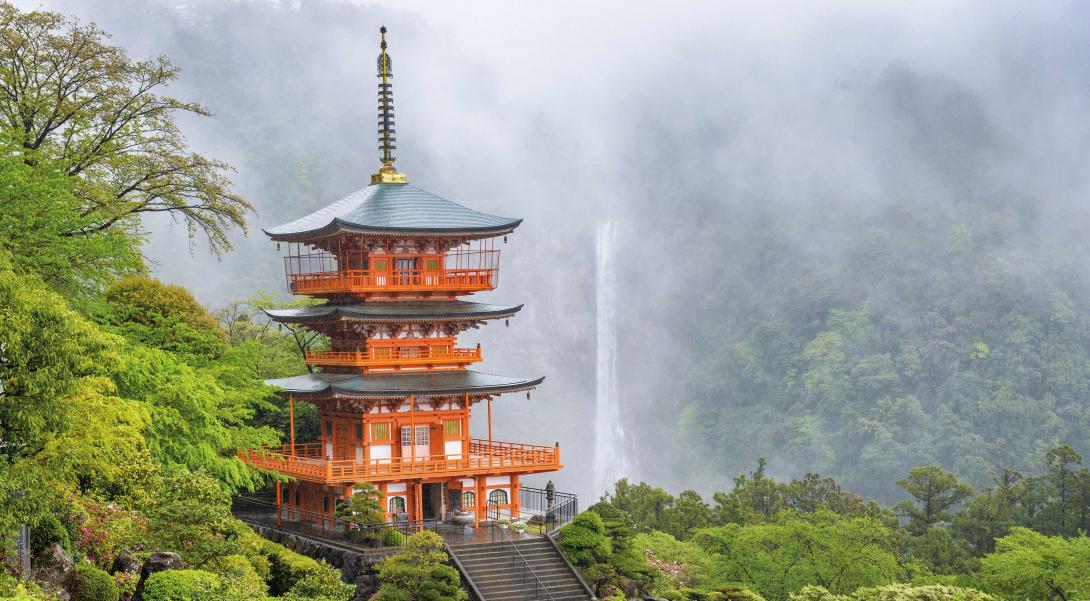
The Kumano route
Along with the Camino de Santiago, it is the only pilgrimage route that is endorsed as a World Heritage Site. The Japanese Kumano Kodo, travelled for the past one thousand years by both emperors and beggars, links three shrines on a network of paths, surrounded by spectacular, natural countryside.
Spiritual peace and a healing emersion into nature
After these uncertain times caused by the pandemic, we need to feel the repairing power of nature more than ever. And few routes on the planet have this aspect, the strength of the millennial Kumano Kodo, a Japanese version of the Camino de Santiago.
Every year, pilgrims from all over the planet wander through this landscape, which brings together impressive temples and lush vegetation, and in which travellers see themselves wrapped in mysterious legends and deep spirituality.
Traversed for around 1,200 years by people from all social classes, from peasants to emperors, the Kumano Kodo is located in the central part of Honshu, the main island of Japan and it is reached a four-hour train ride from Kyoto or Osaka. Since it was declared a World Heritage Site by the UNESCO in 2004, it has seen a boom that has been translated into more visitors, but also into more, improved services that range from the accommodation on offer to the possibility of sending your luggage to the next stretch of the route in order to be able to travel along it lighter.
As in the case of the Camino de Santiago, it is not a single route, but rather a series of pilgrimage paths, through which the three great shrines of Kumano Sanzan are reached: Nachi Taisha, in Nachi, alongside the highest waterfall in Japan, with a height of 133 metres; Hongu Taisha, near to Nanabe, with solemn buildings, roofed with cypress bark and the red Hayatama Taisha, located in the middle of the forest in Shingu.
In addition to these three main shrines, the journey is full of surprises that will fascinate travellers: from mist-shrouded mountains to Oji temples, which are devoted to rest and to purification rites, passing through breathtaking stone stairways, surrounded by vegetation, called Daimonzaka.
Of all the routes, the most popular is the Nakahechi or imperial route, which starts from the coastal city of Tanabe and wends its way towards the mountains for forty kilometres. Those who prefer the coast, can opt for the Ohechi route, with splendid views over the Pacific.
Ryokan, guesthouses or temples: where to stay
There are a multitude of accommodation possibilities in Kumano: guesthouses, hotels and ryokan, traditional accommodation with tatami mat-covered floors, thermal baths and sophisticated cuisine. The first point is to decide whether you want to move around, sleeping each night at a different place, or whether you want to establish a fixed base of operations, such as Tanabe or Shingu. One of the most enchanting options is to stay in a shukubo. These are temples set in the middle of nature (there are over fifty that offer accommodation), which include vegetarian breakfast and lunch, the same menu as eaten by the monks.
Onsen: relaxation for the body, the crowning moment of the day
After a day walking, there is nothing better than relaxing, submerged in an onsen, a traditional Japanese thermal bath. Amongst the most spectacular is the Shirahama onsen, one of the most ancient in the country, which has open air stone pools with spectacular views over the sea. Another option is the Ryujin onsen, with baths that lead directly to a river with mineral waters that have been famous for centuries. Many form part of hotel resorts and in some, such as the Kawayu Midoriya, you can also book a room with its own private onsen.
When to go and what luggage to take for the journey
The ideal months for undertaking a journey in this region are May, June (although it is the rainy season), September and October. It is advisable to travel light, whether sleeping at a fixed place or (particularly) if staying at different places each night. It is essential to wear mountain boots and breathable clothing for protection against the rain, along with carrying sufficient water. It is also a good idea to carry a hat and walking sticks, which are given out along the route, which help to alleviate pressure on the knees. As an alternative, there is a tourist bus that makes the circuit of the three shrines.




